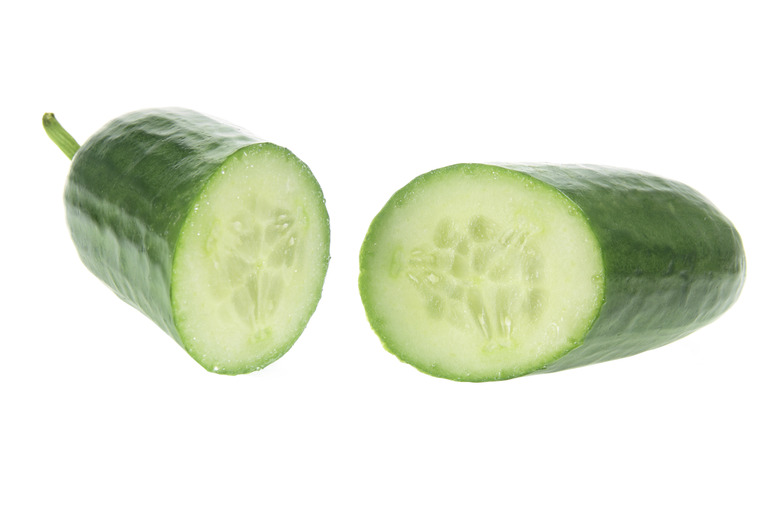How To Grow Lebanese Cucumbers
Thin skins and a mild, sweet flavor make the Lebanese cucumber (*Cucumis sativus*) a desirable variety for home gardeners and salad lovers. While open-pollinated 'Beit Alpha' grows vigorously in the garden, the hybrid 'Sultan' is resistant to disease, vigorous and productive. These warm-weather, tender annuals are easy to grow in a fertile, moist garden.
Step 1
Lebanese cucumbers sprawl across the garden, with vines that grow 6 feet or more long. To contain the vigorous vines, a trellis placed on the north side of the garden, where it won't shade the other fruits and vegetables allows the cucumber vines to grow up instead of out. A trellis also allows air circulation, which reduces diseases such as powdery mildew and scab. Space mounds or raised rows 3 to 6 feet apart when planting seeds or transplanting seedlings. Plant three to six seeds in each mound, or place one seed every 2 inches in rows. Use scissors to snip off the excess seedlings, so the cucumber plants in rows are spaced between 8 and 15 inches apart, and only two or three seedlings are left on each mound.
Enriched Garden Soil
Step 1
A garden enriched with compost provides a loose, rich, fertile soil suitable for cucumbers. By digging in 3 to 4 inches of compost and raking the soil into mounds or raised rows before planting the seeds or transplants, the plants have the fertile, well-drained soils needed to thrive and produce fruits. Continue to feed the plants with compost tea, applying a cup to each plant two weeks after germination and when flowers appear. Add a shovelful of additional compost around each plant when the first fruits set. Alternately, thoroughly mix a 5-10-10 fertilizer into the soil to a depth of 3 to 6 inches, at a rate of 1/4 cup of fertilizer for each plant or mound before planting seeds or transplanting seedlings. Every six weeks, lightly scratch 2 tablespoons of fertilizer into the soil around the base of each plant, keeping it 3 inches from the stems. Water thoroughly after fertilizing the cucumber plants. Use safety equipment when working with soil, compost, compost tea, fertilizers and mulch. Gloves, safety goggles, long pants, long sleeves and shoes protect your hands, eyes and skin from exposure to microorganisms, bacteria, dust and scratches.
Warm -- But Not Too Hot
Step 1
When planting seeds, wait until the soil temperature is above 60 degrees Fahrenheit. Cucumbers germinate quickly in warm, moist soil, appearing above the soil in only three days when soil temperatures are between 80 and 90 degrees Fahrenheit. While cucumbers thrive in a warm, sunny garden, when temperatures rise above 90 degrees Fahrenheit even mild-flavored Lebanese varieties may become bitter. Cucumbers contain cucurbitacin, a bitter-tasting organic compound. When under stress from excessive heat, cold or lack of water, the fruits produce more cucurbitacins. If night temperatures drop below 65 degrees Fahrenheit, protect the cucumber plants with row covers. In hot climates, plant the cucumber vines where they receive dappled afternoon shade or protect them from the afternoon sun with shade cloth or white sheets suspended on bamboo poles.
Evenly Moist
Step 1
As the cucumber vines and fruits develop, they require consistently moist but not waterlogged soil. Water once or twice a week, when the soil is dry to a depth of 3 inches. To add 1 inch of water to the garden, apply 6 gallons of water to every square yard of soil. Adding 3 to 4 inches of mulch around the cucumbers, and pulling it back 3 inches from the stems, slows the evaporation of water from the soil. This helps maintain a consistent moisture level around the plants' roots.
References
- Niki Jabbour – The Year Round Veggie Gardener: Lebanese Kitchen Garden!
- Cornell University: Growing Guide — Cucumbers
- Harvest to Table: Cucumber Growing Tips
- Oregon State University Extension Service: Cucumber Bitterness Explained
- Harvest to Table: How to Grow Cucumbers That Are Not Bitter Tasting
- Ohio State University Extension: Fact Sheet — Growing Cucumbers in the Home Garden
- Burpee: Watering Your Garden
